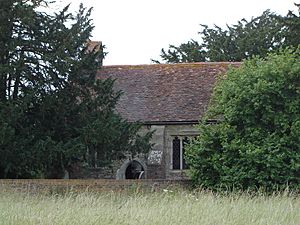St Giles's Church, Tattenhoe facts for kids
Quick facts for kids St Giles's, Tattenhoe |
|
|---|---|

The church from the south
|
|
| 51°59′52″N 0°47′38″W / 51.9978°N 0.7938°W | |
| Country | England |
| Denomination | Church of England |
| Churchmanship | Anglican/Ecumenical |
| Website | www.wvep.org |
| History | |
| Dedication | St Giles |
| Architecture | |
| Heritage designation | Grade II* listed |
| Specifications | |
| Capacity | 55 |
| Administration | |
| Parish | Watling Valley |
| Deanery | Milton Keynes |
| Archdeaconry | Buckingham |
| Diocese | Oxford |
| Province | Canterbury |
St. Giles's Church is a small, old church in Tattenhoe, a part of Milton Keynes, England. It was built in the 1500s and belongs to the Church of England. Even though it's small, it's a very important historical building. It's officially recognized as a Grade II* listed building, which means it's special and protected.
Contents
A Look Back: The Church's Early Days
The very first St. Giles's Church was built here around the year 1200. Imagine, that's over 800 years ago! The old yew trees in the churchyard are just as old. They were likely planted when the first church was built.
The church building you see today was constructed around 1538. It's actually the second church on this spot. It was built using stones from a nearby place called Snelshall Priory. The first St. Giles's Church had fallen apart, so they used materials from the priory to build a new one.
What Happened to the Old Village?
Beyond the churchyard, in the fields, there used to be a village called Tattenhoe. This village disappeared a long time ago. No one knows exactly why it vanished, as there are no records explaining it.
After the Norman Conquest in 1066, the land at Tattenhoe was given to three of William the Conqueror's lords. Later, by 1167, a woman named Sybil d’Aungerville owned both Tattenhoe and Snelshall. She gave land at Snelshall to Benedictine monks. They started a religious community there, which became Snelshall Priory.
Over the next 100 years, many more gifts of land were given to the Priory. Some of these gifts were quite large. This included the areas around St. Giles's where fishponds were located.
Recycling History: Stones from the Priory
When Snelshall Priory was no longer used, its stones were moved. They were used to rebuild St. Giles's Church. You can still see parts of the older building in today's church. For example, the archway of the main door and the base of the font are from the earlier structure.
Modern Times: St. Giles's in a Changing World
For many hundreds of years, until the late 1980s, the area of Tattenhoe was very small. It only had three farmhouses: Tattenhoe Bare, Tattenhoe Hall, and Howe Park Farms. St. Giles's Church stood alone in the fields. It was surrounded by thick woods, open fields, farm animals, and crops.
For 460 years, families from these three farms kept St. Giles's open for worship. People from nearby villages also came. These villages included Whaddon, Newton Longville, Shenley, and Loughton. They would walk across the fields on Sunday evenings in the summer. This helped make sure the church stayed in use for future generations. The beautiful stained glass window in the church was added in 1919.
Getting to the Church: A Journey Through Time
For a long time, the only way to reach St. Giles's was by walking on footpaths through the fields. Before Milton Keynes was built, this was a popular trip for local people. They enjoyed coming to services here. The Harvest Festival service was always the most popular each year. It is still celebrated today.
There was no road to the church until the late 1950s. At that time, a local farmer built a long, narrow track from Whaddon Road to his farm. He kindly allowed churchgoers to use this private track to get to the church. This was the only way to the church until the late 1990s. That's when Portishead Drive and the current car park were built. The old track is now a "redway," which is a path for walking and cycling. It runs north from Hengistbury Lane through Westcroft.
New Beginnings: The Church Today
In 1996, construction began on the first houses of the new Tattenhoe area around the church. In late 1999, the church leaders invited a new group, Immanuel, to hold weekly services at St. Giles's. This group is part of the Watling Valley Ecumenical Partnership.
The church has recently been updated. The walls were repainted, and the pews and other wooden parts were restored in a traditional style. In the summer of 2007, electricity was installed in the church. This made it much more comfortable and modern for everyone who visits.

